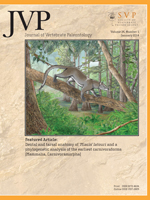This paper describes a new species of elasmosaurid plesiosaur, Aristonectes quiriquinensis, sp. nov., based on a partial skeleton recovered from upper Maastrichtian beds of the Quiriquina Formation of central Chile. The material described here consists of two skeletons, one collected near the village of Cocholgue, and a second juvenile specimen from Quiriquina Island. Prior to these finds, Aristonectes was viewed as a monospecific genus, including only the enigmatic Aristonectes parvidens, the holotype of which consists of an incomplete skull and incomplete postcranium. Other material referred to the genus includes an incomplete juvenile skull and other postcranial material from the upper Maastrichtian of Antarctica, as well as a partial skull from the Quiriquina Formation of central Chile. The relationships of Aristonectes have been controversial, with competing theories assigning the genus to Cryptoclididae, Elasmosauridae, and Aristonectidae; however, there is a developing consensus that Aristonectes is a derived elasmosaurid, and this paper gives strong evidence for this view. Comparison of the specimen here studied with the holotype of A. parvidens demonstrates that A. quiriquinensis is a distinct species. The completeness of the adult skeleton allows the first confident size estimates for adult Aristonectes. It is a large plesiosaurian with a relatively large skull with numerous homodont teeth, a moderately long and laterally compressed neck, and relatively narrow trunk, with slender and elongate forelimbs. The two specimens are restricted to the upper Maastrichtian of central Chile, posing questions concerning the austral circumpolar distribution of different elasmosaurids towards the end of the Cretaceous.
How to translate text using browser tools
1 January 2014
Aristonectes quiriquinensis, sp. nov., A New Highly Derived Elasmosaurid from the Upper Maastrichtian of Central Chile
Rodrigo A. Otero,
Sergio Soto-Acuña,
Frank Robin O'Keefe,
José P. O'Gorman,
Wolfgang Stinnesbeck,
Mario E. Suárez,
David Rubilar-Rogers,
Christian Salazar,
Luis Arturo Quinzio-Sinn
ACCESS THE FULL ARTICLE





